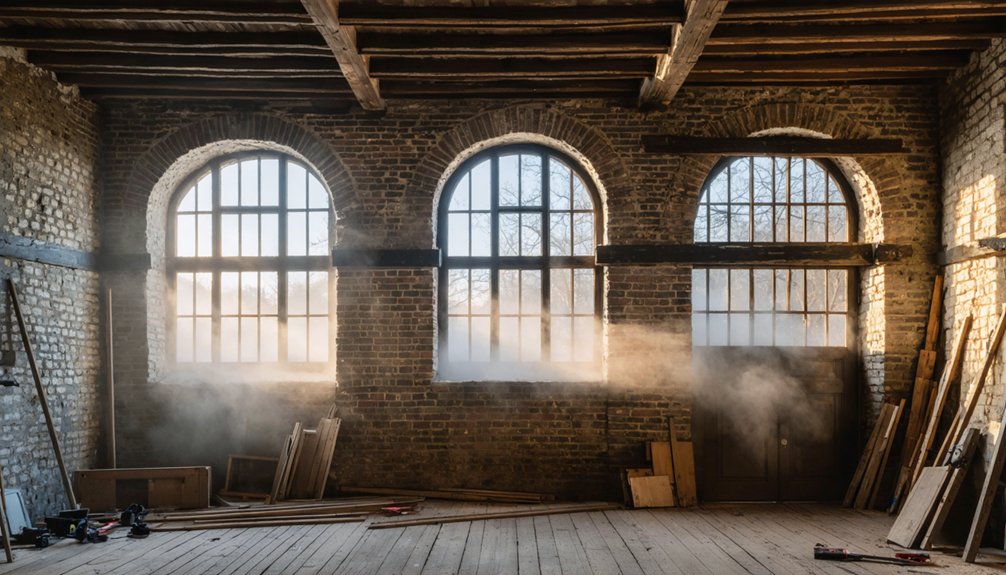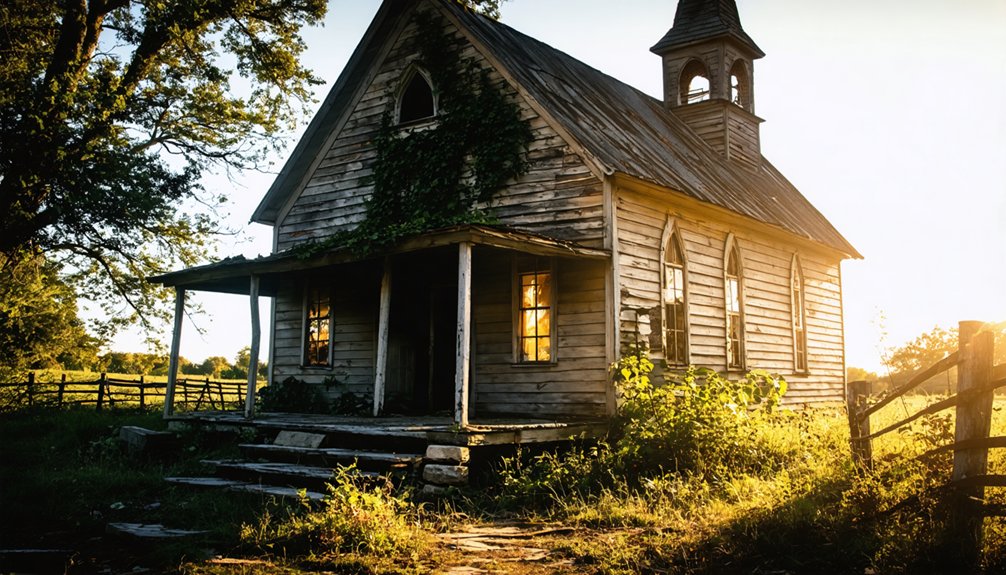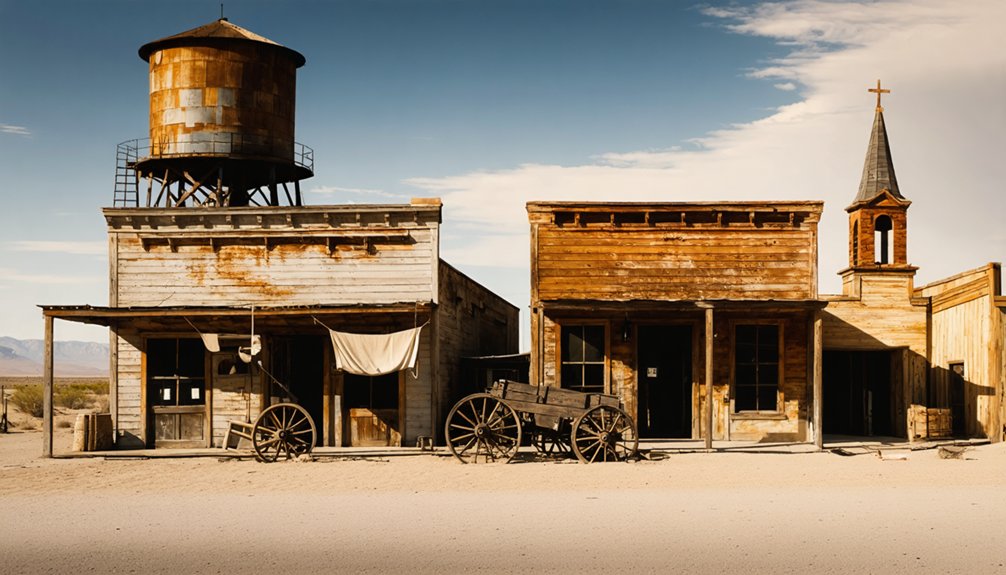You’ll discover three exemplary colonial ghost town restoration projects in Cerro Gordo, Jerome, and Craco. Cerro Gordo employs $1.4 million in period-authentic reconstruction with modern safety systems. Jerome transformed from a copper mining center to an arts haven through adaptive reuse after securing National Historic District status. Craco embraces “beautiful decay” through minimal intervention techniques validated by the World Monuments Fund. These contrasting philosophies offer invaluable insights into preserving historical integrity while ensuring economic viability.
Key Takeaways
- Cerro Gordo’s American Hotel reconstruction uses period-appropriate materials while incorporating modern safety systems for historical authenticity.
- Jerome, Arizona achieved sustainable preservation through National Historic District status and adaptive reuse of mining infrastructure.
- Craco’s “nesting and stitching” approach maintains historical integrity through minimal interventions that prevent collapse while preserving authenticity.
- Successful ghost town restoration projects balance structural preservation with economic revitalization through heritage tourism.
- Effective restoration addresses geological challenges like Jerome’s shifting buildings while maintaining historical character for sustainable community development.
Preserving Mining Heritage: The Remarkable Revitalization of Cerro Gordo
While many colonial ghost towns fade into obscurity, Cerro Gordo stands as a tribute to successful historical preservation in California’s remote Inyo Mountains. Founded in 1865, this silver mining powerhouse generated approximately $17 million by 1900, fueling Los Angeles’ development—a reflection of its historical significance.
Under Brent Underwood’s $1.4 million investment since 2018, restoration efforts balance authenticity with modern safety standards. The American Hotel’s reconstruction uses period-appropriate materials while incorporating contemporary fire protection systems.
These preservation tactics aren’t merely nostalgic—they’re calculated for economic impact through heritage tourism.
You’ll find the revitalization navigates complex challenges: water scarcity, geographic isolation, and structural fragility. The clubhouse displays numerous old pictures and artifacts that tell the story of the town’s vibrant past. Situated at 8,500 feet elevation, the town’s restoration contends with harsh mountain conditions year-round. Yet these efforts create jobs, educational opportunities, and a living repository of California’s mining heritage while adapting historical structures for modern tourism demands.
From Copper Boomtown to Arts Haven: Jerome’s Transformation Journey
Although many former mining sites deteriorate beyond recovery, Jerome, Arizona presents a remarkable case of adaptive resilience. Perched on steep slopes with 88 miles of underground tunnels, this former copper boomtown faced extinction when mines closed in 1953, reducing the population to fewer than 100 residents.
The town’s cultural transformation began in the 1960s as an artistic community occupied abandoned structures. The Jerome Historical Society secured National Historic District status in 1967, facilitating the repurposing of mining infrastructure into galleries and cultural venues. The town was officially promoted as America’s newest ghost town, attracting tourists and new residents alike. Jerome’s reputation as the Wickedest Town in America in 1899 has transformed into a historical highlight that draws curious visitors.
Technical challenges remain significant—buildings like the “Sliding Jail” continue shifting downhill due to geological instability from mining operations. Despite these constraints, Jerome’s population stabilized around 450, creating a sustainable creative economy.
This model demonstrates how heritage preservation can successfully intersect with geotechnical solutions to revitalize deteriorating historic settlements.
Embracing Beautiful Decay: Craco’s Approach to Historical Conservation
Unlike fully restored heritage sites that often sacrifice authenticity for aesthetics, Craco’s conservation philosophy represents a paradigm shift in historical preservation approaches.
You’ll find conservationists employing “nesting and stitching” techniques that maintain historical relics while introducing sensitive contemporary interventions. This methodology embraces decay aesthetics rather than erasing them, preserving the evocative atmosphere of abandonment that makes Craco uniquely compelling.
The approach guarantees heritage continuity through thoughtful structural stabilization without compromising the town’s medieval character. The town’s inclusion on the World Monuments Fund Watch List in 2010 further validated this preservation strategy. By limiting interventions to prevent collapse rather than reconstructing, preservationists maintain Craco’s authentic patina—from open church naves to rusted balconies.
Craco survives through minimal intervention—preserving authenticity while preventing collapse, maintaining each weathered stone’s testimony to time.
This deliberate preservation of “beautiful decay” offers visitors an unfiltered connection to history while supporting the local economy through sustainable tourism that respects the site’s fragile geology and cultural significance. The Re-Craco initiative aims to transform the ghost town through landscape heritage regeneration, balancing preservation with carefully considered development.
Frequently Asked Questions
How Do Restoration Projects Secure Funding for Long-Term Maintenance?
You’ll secure long-term maintenance funding through structured grant applications to federal/state programs, strategic tax incentives, community partnerships for recurring revenue streams, and thorough documentation justifying ongoing financial support.
What Qualifications Do Restoration Specialists Need for Ghost Town Projects?
You’ll need IICRC certifications, historic preservation expertise, hands-on restoration techniques, knowledge of period-specific materials, and documented experience with structural stabilization. Historical expertise in colonial architecture is essential for authentic conservation.
How Do Restorations Balance Modern Safety Codes With Historical Accuracy?
You’ll preserve historical integrity through documentation, reversible interventions, and applying for code variances, while achieving safety compliance through sensitive adaptations that don’t falsify historical elements or compromise authentic materials.
Can Private Owners Purchase Properties Within Restoration Zones?
The doorway to private ownership stands open—you can purchase properties in restoration zones, though your restoration rights may be constrained by NRHP designations, preservation ordinances, and zoning requirements affecting historical integrity.
How Are Priorities Determined When Multiple Structures Need Urgent Preservation?
You’ll determine preservation priorities through urgent assessments evaluating physical condition, historical significance, community value, and resource availability. Each structure’s unique characteristics and deterioration level will inform your preservation strategies.
References
- https://travelnoire.com/reviving-ghost-towns-sustainable-tourism-in-abandoned-places
- http://dspace.mit.edu/bitstream/handle/1721.1/7985/53009829-MIT.pdf?sequence=2
- https://www.youtube.com/watch?v=a-5_HILuIT8
- https://dot.ca.gov/-/media/dot-media/programs/environmental-analysis/documents/ser/townsites-a11y.pdf
- https://www.loveexploring.com/gallerylist/494432/before-and-after-abandoned-towns-that-came-back-from-the-dead
- https://api.drum.lib.umd.edu/server/api/core/bitstreams/73433299-2c03-4182-9d06-ef0225383615/content
- https://ronnysalerno.com/queencitydiscovery/2018/01/the-ghost-town-of-amargosa.html
- https://www.youtube.com/watch?v=1nZFQl4N408
- https://www.youtube.com/watch?v=30V5Bf6WWeU
- https://roadtrippers.com/magazine/cerro-gordo-ghost-town/



